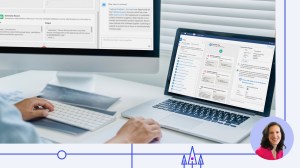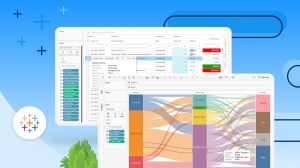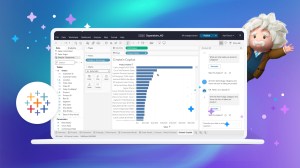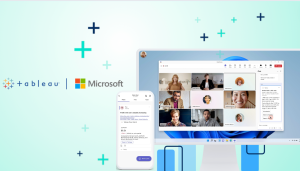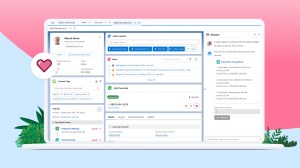Generative AI and large language models (LLMs) are reshaping how companies build business applications for sales, customer service, marketing, commerce, IT, finance, legal, and HR teams. Behind this shift is a legion of app developers who are tapping into generative AI-powered development tools to build apps faster and augment employee experiences for the better.
That’s a big reason why 86% of IT professionals say their jobs have become more important since the introduction of generative AI.
Here, Alice Steinglass, Salesforce’s EVP & General Manager, Platform, shares her thoughts on the future of AI-powered app development, the collaboration between developers and AI copilots, and more.
Q. What are the top trends you’re seeing in the app dev space?
AI is what every developer, CIO, and frankly, every organization is talking about. We’re going to see a dramatic revolution in the kinds of apps available on the market — and how they’re being built.
Initially, AI was used for simple tasks like recommendation systems and voice recognition. With advancements in deep learning and Natural Language Processing (NLP), AI is now capable of helping with complex tasks such as image recognition, sentiment analysis, and predictive analytics. And with generative AI, we now see apps that are capable of generating highly personalized content like images, webpages, and emails customized for individual users.
It’s a dramatically new way of thinking about development, and it provides a new kind of experience for the end user.
Alice Steinglass, Platform EVP & General Manager, Salesforce
AI is also changing how we build apps — moving from click-based UIs to conversational UI, from hard-coded logic to semantic LLMs, and from limited structured data to unified data layers leveraging structured and unstructured data in decision-making.
What I find so interesting about building apps with AI is the unexpected. Developers have to think of all the different scenarios that could happen — envision what kind of new workflow their end users will need. The amazing part about using a copilot is that it’s able to generate a plan in real time at runtime for the user based on the capabilities that I give it as a developer. It’s a dramatically new way of thinking about development, and it provides a new kind of experience for the end user.
With AI assisting them every step of the way, experienced developers can code and build faster. And at the same time, AI can democratize the app dev space by lowering the barrier to entry and opening the door for more business users to be able to build apps themselves.
Q. What is the single biggest challenge in using AI for app development?
The AI revolution is a data revolution. Companies are struggling with vast amounts of data “trapped” across too many apps and silos, making it difficult to amalgamate into a single, useful dataset. With access to large quantities of data, using a hyperscale data engine like Salesforce’s Data Cloud, AI’s potential expands, especially when you can pair these new AI capabilities with your unstructured data.
When we talk about data, about 20% of it is structured data. This is what you would find in spreadsheets and transactional databases — names, customer information, and order details. However, the remaining 80% is unstructured data, including PDFs, emails, transcripts, and social media content. Previously, finding relevant information through this unstructured data was challenging, requiring exact keyword matches.
With AI, we now have patterns like retrieval augmented generation (RAG) that help companies retrieve and use their data, no matter where it lives, for better AI outputs.
This is transforming the way software is written and enhances the customer and employee experiences companies can offer today.
Q. What does it take to build powerful AI apps?
First, the app needs to have access to the right data and metadata. Without the necessary data, an AI app becomes nothing more than a party trick. For example, if I asked a chatbot to simply “generate an email,” the resulting email would lack contextual relevance without the required information. Who am I sending the email to? What details should be included? Gathering all of this information can be a cumbersome task for the end user.
This is where app development plays a crucial role. As app developers, we can take the responsibility of gathering the necessary data and metadata for the user. We can identify the structured and unstructured data, as well as any relevant information, to effectively use AI in a given scenario.
Q. What else should developers consider when building or integrating AI-powered apps in an enterprise?
It’s not enough to generate the perfect email — if a salesperson or customer agent has to manually copy and paste the content from somewhere else to send it, that becomes an extra step and hinders productivity. That’s why it’s critically important to incorporate AI into the workflow itself. This means having AI functionalities as buttons on the page, part of the copilot, and embedded into the organization’s existing workflows.
Additionally, the AI app should have deep integrations with the systems where actions take place. In an enterprise setting, there are often numerous systems involved, with over 900 different systems being used for various tasks like creating purchase orders, checking shipping status, and placing orders. A powerful AI app not only analyzes data and provides intelligent insights, but also operates within the user’s workflow, taking real actions on their behalf. It goes beyond generating text and is capable of executing meaningful actions for the user.
Salesforce’s Einstein Copilot, for example, allows companies to create custom actions leveraging their CRM data and existing workflows, APIs, and code.
Q. How is collaboration between developers and AI copilots shaping the future of app development?
For experienced developers who know how to write complex code, collaboration with AI speeds up the development process. Oftentimes, there’s a lot of boilerplate code that needs to be written, and one of the top requests from our developer community is test case generation with AI. This is an area where AI can truly assist. Developers can write a piece of code that is crucial for their users, and AI can provide a starting point for test cases, saving time and allowing developers to focus on making them specific to their organization.
Secondly, collaboration with AI copilots democratizes app development by making it accessible to more people. It can help beginners get started, fill in missing information, and even explain concepts and functions. When learning new technologies, such as making an Apex callout, AI acts as a supercharged assistant, providing guidance and support throughout the process.
Lastly, AI presents an opportunity to improve the quality of the code being written, elevating the type of code that developers write and their reliability. This is just the beginning, as there is untapped potential in using AI for performance optimization, scalability, bug detection, and enhancing code reliability.
Q. How does low-code development intersect with AI and what are the implications?
Low-code developers will play an exciting role enabling actions within AI.
When implementing AI in an enterprise setting, it becomes crucial to determine the places you want to embed AI capabilities and the actions that the copilot should be able to take. Low-code developers are often business users or administrators who have a closer connection to the needs of the business. This proximity allows them to collaborate with business stakeholders to understand their needs and implement AI solutions accordingly.
Whether it’s sending an email, initiating a purchase order, or making an order request, low-code developers can work closely with business units to understand the specific data requirements for each action. Then, they can identify the necessary data sources and integrate them into the AI system.
Low-code tools like Prompt Builder empower Salesforce Administrators to create, ground, test, and implement AI across experiences, apps, and workflows. And, AI can also help them build these workflows. Tools like Salesforce’s CodeGen — a new, large-scale language model built on the concept of conversational AI programming — allow low-code developers to deliver on the needs of the business.
Q. What’s your vision for the future of AI-powered app development?
AI will become an integral part of every app, creating truly personalized UX that collaborates with the user to provide intelligent insights and accomplish tasks. And, multimodal input will transform how we interact with software — particularly on mobile.
What’s more, how we build these apps will change. AI-powered app development platforms will continue to get better at helping us realize our goals through code: democratizing development while also supercharging engineering productivity with more support, better testing, and higher quality code. Basically, it will let developers, admins, and architects spend more time on the fun part — creating and building — and less time looking up how a library works, debugging esoteric issues, or writing boilerplate tests. It’s going to be a fun time to be a builder.
As AI continues to advance, its impact on app development will become increasingly significant. From enhancing functionality to improving security measures, AI is transforming the way apps are built and experienced. With collaboration between developers and AI copilots, the democratization of AI development, and the intersection of low-code development with AI, the future of AI-powered app development looks promising.
More information:
- See all the latest news from the TrailblazerDX conference
- Get the latest details and availability on Einstein Copilot, Salesforce’s new customizable, conversational, and generative AI assistant for CRM
- Read how Data Cloud became Salesforce’s fastest-growing organic innovation
